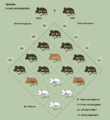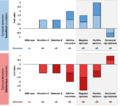Epistasis facts for kids
Epistasis is a cool idea in genetics where different genes work together or affect each other. It's like a team effort, but sometimes one gene can boss around another! The word "epistasis" was first used by a scientist named William Bateson in 1909.
Think about Gregor Mendel and his famous experiments with sweet pea plants. He looked at simple things like if peas were round or wrinkled, or if plants were tall or short. Mendel found that each trait was controlled by a pair of "factors" (what we now call genes). The important part was that one pair of factors never changed what another pair did. They acted independently.
But with epistasis, things are different! The way one gene acts can totally change or even hide the effect of another gene. This can happen even if the genes are on different chromosomes. It's like one gene has the power to "mask" or cover up what another gene is trying to do.
Contents
How Genes Interact
When genes show epistasis, it means their effects aren't just added up. Instead, one gene's presence can stop or change the way another gene shows up. This makes genetics more complex and interesting than just simple dominant and recessive traits.
Epistatic and Hypostatic Genes
In epistasis, we often talk about two types of genes:
- Epistatic gene: This is the gene that does the "masking." It hides or changes the effect of another gene.
- Hypostatic gene: This is the gene whose effect is hidden or changed by the epistatic gene. It's like the hypostatic gene is waiting for its turn, but the epistatic gene steps in first!
Real-Life Examples of Epistasis
A great example of epistasis can be seen with hair color and baldness.
- Imagine you have genes for blond hair or red hair.
- Now, imagine you also have a gene for total baldness.
- If someone has the gene for total baldness, it doesn't matter what hair color genes they have. The baldness gene is epistatic to the hair color genes. It completely covers up their effect.
- The hair color genes are hypostatic because their effect (showing hair color) is hidden by the baldness gene. You can't see the hair color if there's no hair!
Another example is in animal coat colors. Sometimes, a gene controls whether any pigment (color) can be made at all. If an animal has genes that say "no pigment," then all the other genes for specific colors (like black, brown, or yellow) won't matter. The "no pigment" gene is epistatic, and the color genes are hypostatic.
Images for kids
-
An example of epistasis is the interaction between hair colour and baldness. A gene for total baldness would be epistatic to one for blond hair or red hair. The hair-colour genes are hypostatic to the baldness gene. The baldness phenotype supersedes genes for hair colour, and so the effects are non-additive.
-
Quantitative trait values after two mutations either alone (Ab and aB) or in combination (AB). Bars contained in the grey box indicate the combined trait value under different circumstances of epistasis. Upper panel indicates epistasis between beneficial mutations (blue). Lower panel indicates epistasis between deleterious mutations (red).
-
The top row indicates interactions between two genes that show either (a) additive effects, (b) positive epistasis or (c) reciprocal sign epistasis. Below are fitness landscapes which display greater and greater levels of global epistasis between large numbers of genes. Purely additive interactions lead to a single smooth peak (d); as increasing numbers of genes exhibit epistasis, the landscape becomes more rugged (e), and when all genes interact epistatically the landscape becomes so rugged that mutations have seemingly random effects (f).
See also
 In Spanish: Epistasia para niños
In Spanish: Epistasia para niños





